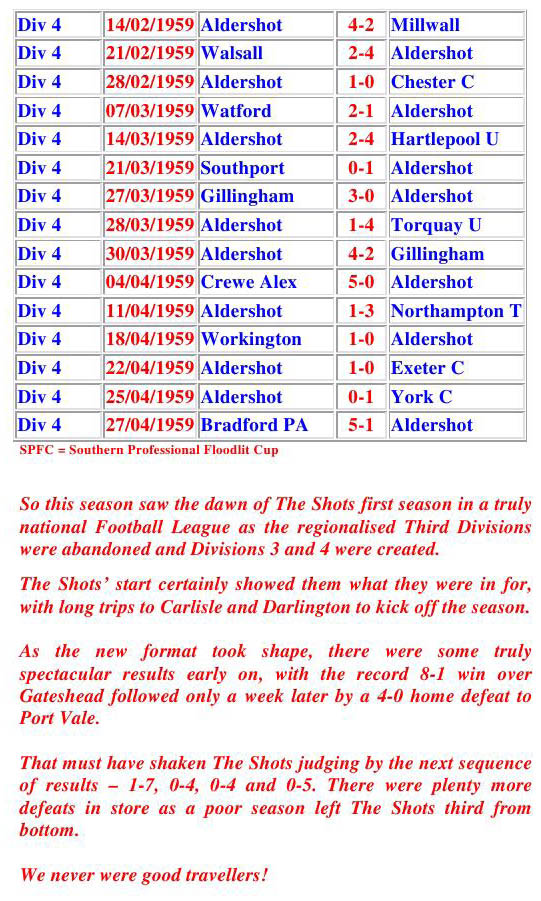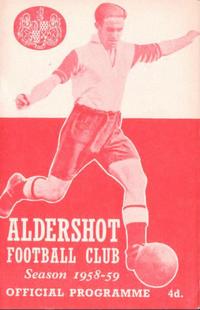Aldershot
Echoes - 1958/9
The 1957/8 season had been the last with regionalised North and South Third Divisions. The top twelve clubs formed the new Third Division and the bottom twelve the Fourth Division. Aldershot had finished in 18th place, seven seasons passing since their last top half finish. The national composition of Division Four

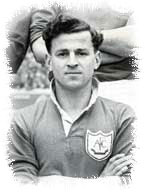
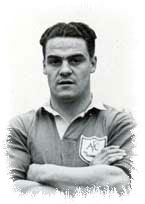
Jimmy Gaynor Norman Menzies Bill Lacey
meant an increase in travel for Aldershot from 4,500 miles to 8,000, and Shots first matches in League competition against all twelve of the northern clubs.
There were quite a number of incoming players including goalkeeper Chic Brodie (Gillingham), defender Don Pearson (Swansea), Denis Howe (Southend), winger Denis Parnell (WBA) and striker Dennis Pacey (Millwall). Notable departures were long-serving forward Ken Flint to Leyton Orient after 81 goals in 354 appearances, Jimmy Gaynor (182 appearances 42 goals) to Cambridge City, keeper Keith Amos (87) to Fulham and Norman Menzies, 242 appearances 97 goals) to Tonbridge. Of Aldershot's entire playing staff only Bill Lacey, signed from Middlesbrough in 1952, had been with the Shots longer than the previous season.
Opening day saw a 1-0 defeat at Carlisle in front of 9,912, the highest attendance at all Aldershot's northern visits that season. A 3-2 win at Darlington was followed by home defeats to Barrow and Darlington as Shots slipped down the table. The visit of Gateshead on 13 September drew 4,849 to The Rec, a change of keeper was necessitated due to an injury to Brodie, the previous season's deputy Roy Marshall coming in. Unexpectedly it was Aldershot's attack that rewrote the record books, the 8-1 win Aldershot's highest ever League win. Robbie Stepney (who went onto make 233 appearances over 7 seasons) playing his third game since signing from Redhill and Bill Lacey (1957/8's 18-goal top scorer) both netted hat-tricks with Terry Matthews scoring twice. Line-up: Marshall, Henry, Jackson, Mundy, John Price, Gough, Walters, Stepney, Lacey, Matthews, Tyrer.
However the same eleven drew blanks in a home draw with Shrewsbury, although described as "a rattling good game...we can ask nothing better of the side than a good ninety-minute one-hundred per cent effort as they gave us…A tribute is due to the supporters who so enthusiastically urged the team on, it is doubtful if any team has received more encouragement than ours did", in the programme for the following 0-4 home drubbing against Port Vale. Worst was to come at Coventry, the only change Pearson replacing Tyrer, but a 7-1 defeat the outcome. With seven players including both keepers injured, Terry Knight from Alton Town was drafted into keep goal. Four consecutive defeats without scoring saw Shots fall to the foot of the table. The run of losses was stemmed by a 2-2 draw at Chester, Derrick Price scoring his only Aldershot goal, and a goalless home draw with Watford in which Peter McMahon made his debut having signed from Leyton Orient.
By the long trip to Hartlepools United on 25 October Aldershot had just 9 points from 16 games with just Gateshead below. The only previous visit to Victoria Park had seen Shots comprehensively beaten 4-0 in the FA Cup Second Round four years previous. League football in the North East was clearly more to Shots' liking as after 6 seconds Albert Mundy scored the fastest ever goal in Football League history. Bill Lacey added two goals, his first without much involvement as a rebound off the post hit him and went in. November brought an early exit from the FA Cup, losing 5-0 at Swindon Town, and a second home win of the season, against Southport, before three home matches against northern sides in the run-up to Christmas collected a handy five points. Though the 3-3 draw against Bradford Park Avenue drew just 3,154 spectators to The Rec, matches against Workington and Carlisle were gates both below 4,000.
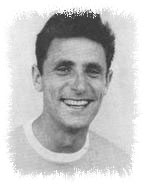

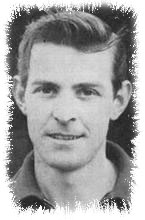
Arthur Tyrer Robbie Stepney George Norris
Crystal Palace were Boxing Day visitors to The Rec, winning 2-1. The next day at Selhurst Park they increased the winning margin to 4-1 in front of 19,344 fans. With funds tight and a losing side manager Harry Evans could make no changes to the playing personnel.
The programme's format greatly changed from a flimsy 8-paged 23.5 x 18 cm format, which had barely altered in ten seasons, to a more recognisable programme style sized 18.5 x 12 cm, still printed by John Drew (Printers) Ltd as it had been since the club's Southern League days. This era saw football programme collecting as a hobby take off, the trend broadly towards more compact issues, with slightly increased club information and better paper quality. The front cover was strikingly red and white, dominated by a full-length action shot of a player (an Accrington Stanley player!). This cover and the price of 4d (which the previous season had increased by a penny) were consistent for five seasons.
Aldershot started 1959 in 23rd position in Division Four but won their first match of the year 4-3 at fellow strugglers Barrow, the goals from Stepney, Pacey and Tyrer (2). This was followed by five winless games, the fourth a 1-0 loss at resurgent Gateshead. Shots played the better football, but failed in front of goal. It was a bleak trip all round costing the club £140 in expenses with proceeds from the meagre 2,903 gate barely £40. The fifth consecutive defeat came at top of the table Port Vale but Aldershot were unlucky to lose to the odd goal in five. Local lad George Norris stepped up from local football, via the Reserves, and scored both Shots' goals. Norris followed this with a second brace in the 4-2 home win against Millwall. Norris missed the next two matches but Shots upturn continued winning at Walsall (4-2) and home to Chester (1-0). Finally there was some optimism around the club as the Shots moved up to seventh from bottom, although it was acknowledged "we have no time for complacency and must fight for every point".
But in a confidence sapping final two months of the season Shots won just twice at home and once away (Southport) in twelve games, losing on the other nine occasions. The final four home matches drew an average of 2,901 fans, the lowest crowd of the season 2,567 for Northampton's visit. Whilst this was not good for Aldershot's finances this was also the era of shared gates. In the regionalised Third Division era the bottom two clubs of each division were forced to apply for re-election to the Football League, in competition with ambitious non-league clubs. The two greatest counts against a League member were geographical remoteness (Hampshire was remote to the many northern and midlands clubs) and small gates which meant a smaller share of the revenue for visiting sides.
Aldershot ended the season in 22nd place with 35 points. Shots previous re-election applications in 1937 and 1949 had seen quite a close run vote with Ipswich Town first time around, although Shots had been comfortably returned ten years ago. Fellow re-election candidates were Southport and Barrow, both of who had faced re-election five times, and Oldham Athletic who had never been through the process. The clubs faced a very strong challenge from Peterborough United who had won a fourth consecutive Midlands League Championship, dropping only 4 points, and taken Second Division runners-up Fulham to a FA Cup Third Round replay.
No club had been voted out of the "closed-shop" Football League since 1951, when Workington Town replaced New Brighton, but Peterborough United had been the best supported non-league side for the past five seasons. Whilst Oldham were comfortably returned with 46 votes Southport (34), Barrow (32) and Aldershot (31) were all run close by Peterborough who received 26 votes. Eight other non-league clubs vying for a League place gathered a combined 23 votes. Both Worcester City and Headington (Oxford) United received 7 votes, votes which had they gone to Peterborough would have ended Aldershot's League membership. Peterborough United were elected the next season, replacing unfortunate Gateshead who were applying for re-election for the very first time!
A total of 26 players were used in the campaign, Jimmy Jackson played the most matches (39) followed by Albert Mundy (36), Robbie Stepney (35), Denis Howe (33), William Walters (33) and Don Pearson (31). Stepney with 10 goals was the only player to reach double figures. Dennis Pacey was next on 9 (in 21), Bill Lacey on 8 (from 29), whilst George Norris scored 6 in his 9 appearances. Lacey was transferred to Reading for £500 after 70 goals in 231 games (Shots all-time sixth highest goalscorer). Of the 26 players used 10 never appeared in a Shots shirt again, most dropping out of the Football League, including Howe and Pearson. After four seasons in charge manager Harry Evans had his contract terminated in June.
Regionalisation had some interesting results; the top twelve clubs in Division Four comprised ten who'd come from Division Three South and two from North, with the split reversed in the bottom half. Only Watford in 15th accompanied Shots in the northern oriented bottom half, whilst third-placed York City and Carlisle in 10th broke the southern dominance. Of the four clubs relegated from Three to Four Rochdale, Doncaster and Stockport had all been in Three (North) the previous season, whilst Notts County made it consecutive relegations having previously been relegated from Division Two.
Post-war attendances in the Division Three South had consistently been 40% higher than the attendances in Division Three North. When the divisions were changed Division Three averaged around 40% higher attendances than Division Four. This would have had a marked financial effect on the southern clubs in Division Four whose share of away gates dropped from around 10,000 to less than 7,000. Shots home attendances averaged 4,189, down 16% on the previous season. This was Shots third lowest average ever, and comparative to other Football League clubs the worst they ever were (until 1989-90), just two other clubs drawing lower crowds.
Elsewhere Wolverhampton Wanderers were First Division Champions for the third time in the 1950s. Manchester United and Arsenal finished second and third. Sheffield Wednesday won the Second Division and Plymouth Argyle the inaugural Third Division. Nottingham Forest beat Luton Town 2-1 in the FA Cup Final.
With grateful thanks to Martin Gooday for generously giving his permission to reproduce this series.







